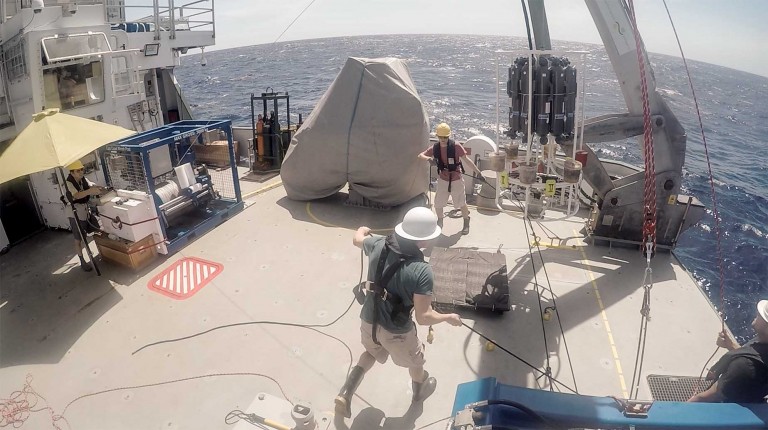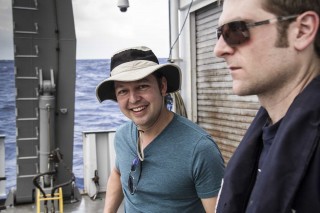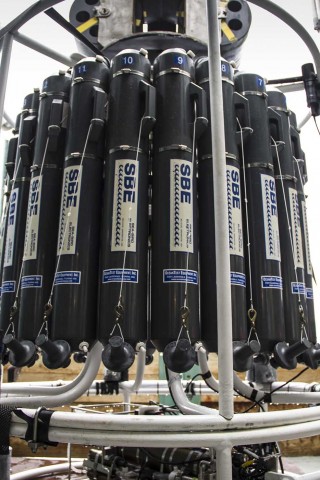
A well-known metaphor compares planet Earth’s environmental procesess to the functions of a living organism. This comparison takes on a new meaning when applied to the novel technologies being used on this cruise by the scientific team onboard R/V Falkor.

When the medical community started using biomarkers and mass spectrometers for the diagnosis of cancer, Dr. Mak Saito saw an opportunity: How would these methods work on the ocean?
Mass spectrometers can measure and identify molecules in a given sample. What if we could identify biomarkers or measurable indicators of the state of marine microbiological ecosystems through the proteins they’re producing?
That question drove Dr. Saito to embark on a quest to apply the same technologies that evaluate the health of a human patient to the health of our living planet.
Dr. Saito explains further:

SOI: It seems that more than simply collecting information, your team is actually creating a tool. Is that right?
Saito: The study of proteins has rarely been applied to the oceans. That’s why our lab is very unique. We were the first team to put out quantitative protein profiles in the oceans.
One thing we are trying to do here is to develop biomarkers just like our colleagues are doing in the medical community. We’re using the exact same technology and then building on it, because when someone’s trying to find cancer in someone else’s blood they’re just trying to measure human. Whereas we’re trying to take a sample from the ocean and we might have a 100 or a 1,000 or 10,000 organisms mixed up together and that’s actually a much more complicated problem.
SOI: Does it seem to work?
Saito: It turns out biomarkers function very well in the oceans because what microbes are doing is usually very extreme. If they’re starving of something they create a lot of a given enzyme. We’re looking for that marker that says that that microbe is starving of *this here* or doing *this chemical reaction* there. What we’re trying to do is assemble a portfolio of biomarkers so that we can take a diagnostic sweep and say we know a whole lot about what the ecosystem is feeling or doing just from this one sample we took.
SOI: And yet this technology is barely starting to be used at clinics right now.
Saito: We had no one in the community to learn this technology from. I had to go to medical conferences to learn what was happening. To get here, with this technology, there was a lot of banging our heads against the walls to be honest, and a lot of medical meetings to try to pull the technology in. So yes, this technology hasn’t even hit the clinics yet. We’re really deploying it in real time, as the medical community is deploying it.
SOI: Why is it so important to work with proteins?
Saito: Proteins have been of interest for a very long time, but people were not sure they were going to be useful. The difference is that DNA shows what the potential is for something to happen; life has genes and they might or might not be turned on. But you don’t know that when you’re looking at DNA because you are looking at an entire footprint and its possibilities. RNA takes you a little closer but turns out RNA responds so quickly that it is a little difficult to interpret the signals.
One of the holy grails has been asking what the organisms are actually doing, not just their potential. And so the proteins let you see exactly what they’re doing. And that takes us to their function, very precisely.
SOI: What is the benefit of this new knowledge for human well-being?
Saito: My main motivation is, “Can we build something that will really help us?” If we really want to live sustainably on this planet, we already have 7-billion-plus people and we are influencing almost every element on the periodic table that we extract or have interaction with, we are a big enough population that we can manipulate our planet’s chemistry.
We might not be ready to acknowledge this as a society and as a community of voters yet,
but I think we need the tools to assess what the planet’s ecosystems are doing so that we can really understand how they are changing, and how we’re influencing it. So we are trying to lay this foundation of a method that can really give us a deep diagnosis of what the ecosystems are doing.

